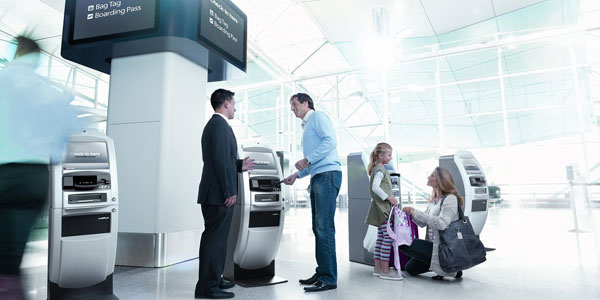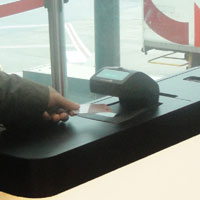At the end of June, Qantas completed the Australia-wide rollout of its Next Generation Check-In Program. The programme is one of the industry’s most innovative and the combination of self-service and latest generation technology is designed to redefine the airport experience for the passenger.
According to Gabriella D’Alessandro, Head of Next Generation Check-In Program, the system has received “outstanding feedback” since the initial implementation last year. “For our Frequent Flyers who use their Qantas Card at a Q Card reader, check-in can now be completed in five seconds; a significant reduction in check-in time,” she said.
“Next Generation Check-In technology is also delivering speed and ease for baggage check-in, with the Automatic Bag Drop process effectively eliminating queuing for and significantly reducing the amount of time required to check-in a bag.”
In order to increase the efficiency of passenger and baggage processing, the latest technologies have been adopted, including Radio Frequency Identification (RFID) technology, which is the basis of both the Q Card and the Q Bag Tag.
Frequent Flyers can use their Qantas Card to check-in simply by touching it against a Q Card Reader. An SMS is then automatically sent to the passenger’s mobile phone and the Qantas Card then becomes the boarding pass. The Q Bag Tags meanwhile are a permanent alternative to the traditional paper tags and the passenger can drop their bag at a bag drop, scanning their Qantas Card to identify themselves. Any baggage charges can also be paid immediately using a credit card.
“The characteristics of RFID technology were identified early on in the process as a key enabler in our vision and it was subsequently trialled and developed to deliver the business proposition,” D’Alessandro continued. “RFID has been successfully used in the airline industry in paper (thermal) bag tags previously. The Q Bag Tag takes the RFID technology one step further by providing a permanent bag tag solution and eradicating the need for a paper tag.”
Passenger power
In order to make its vision a reality, Qantas partnered with a number of suppliers, including the likes of Amadeus, Access IS and IBM to deliver specific parts of the project. For instance, Amadeus’ Altéa Departure Control system is used by the airline and the company also offered consultancy and assisted with the development of new channels for the bag drop, baggage tagging and baggage policies.
According to Patricia Simillon, Head of Airlines Operations Strategy, Amadeus, the idea at the heart of the project is to give the passenger control over their journey.
She explained that the initial vision was divided into four blocks: self-service; baggage (including both baggage tracking to enhance the passenger experience and cost reduction for the airline); resource optimisation; and innovation to enhance service.
Based on these four principles, “what has been developed is a total solution from kiosk to payment and all of it is in the spirit of giving power to the passenger”.

Developing Next Generation Check-In
In order to implement Next Generation Check-In across Qantas’ entire domestic network, D’Alessandro explained that significant infrastructural upgrades had to be undertaken at each of the airports.
“Qantas installed Automatic Bag Drops, newly designed check-in counters, cluster zones of self-service kiosks and customer service points,” she said. “This completely transformed the airport terminal space for improved customer movement through the terminal.” These installations were in addition to the Q Card readers, baggage repack areas and weighing scales.
With the implementation complete across Australia, D’Alessandro explained that Qantas is “currently looking for opportunities to roll out Next Generation Check-In across the Tasman by installing Q Card reader technology”.
While the benefits of expanding the programme to New Zealand’s airports are clear for Qantas’ Frequent Flyers, Amadeus’ Simillon explained that the project could be a catalyst for a more widespread improvement in passenger and baggage processing.
“Next Generation Check-In is a project that we approached with an open mind and we have developed a number of specifics for Qantas, but I would say that the products could be used more widely in the airport of the future,” she said. “If all stakeholders work together, we can create a tremendous experience for more passengers. Next Generation Check-In has really made a huge difference.”
Gabriella D’Alessandro, Head of Next Generation Check-In Program, Qantas, will address delegates at Future Travel Experience 2011, Vancouver, September 7-9. She will explore the question: ‘Has Qantas’ Next Generation Check-In Program truly delivered a next generation passenger experience?’ More information can be found here.

Navigating the Airport of Tomorrow – A global report commissioned by Amadeus
The recent travel industry report, Navigating the Airport of Tomorrow, identifies changing attitudes to the modern airport and charts the airport systems and technologies that over the next ten years will attempt to solve passenger frustrations whilst also delivering the much anticipated “total travel experience”.
Authored by Norm Rose of Travel Tech Consulting Inc, the report reveals that passengers across the world are regularly still suffering significant problems whilst at the airport including when checking-in, collecting and dropping off baggage and passing through security checks.

Access IS develops Q Card reader
Access IS developed the BGR125, an enhanced version of their current BGR120S 2D boarding gate reader, to include the RFID functionality necessary to read and authenticate the Qantas Cards which will act as the passengers’ permanent boarding passes.
The BGR125 continues to read 2D barcodes printed on paper tickets and cell-phones. The device reads barcodes face-up, proven to be quicker and more intuitive for passengers and agents to use.
Access IS incorporated firmware to integrate with the Altéa Departure Control system.
Passengers are able to simply touch the base of the boarding gate reader with their Q Card to board their flight. The readers response time is identical to a bar coded document. A printer can be directly connected to the BGR125 to allow a receipt to be issued to ease location of the passenger’s seat. Access IS was also able to offer an upgrade for Qantas’ previously installed BGR120S units.

IBM’s Next Generation solution
IBM has played an integral role in the development and implementation of Qantas’ Next Generation Check-In programme.
The company worked closely with Qantas’ industrial design firm to produce the Q-reader.
IBM’s multichannel solution was used to provide the self-service applications on the Q-reader, check-in kiosk and vending kiosk.
As requested by Qantas, the Q-reader allows for the passenger to be checked-in automatically in just five seconds; satisfies the concept of “speed and ease”; automatically recognises the passenger’s frequent flyer status; and improves the overall passenger experience.
IBM has also developed the Q Bag Tag vending machine, which allows passengers to purchase additional RFID baggage tags.
Having been involved in the Next Generation Check-In programme since mid-2009, IBM continues to provide enhancements, project management, maintenance and support services to Qantas.








